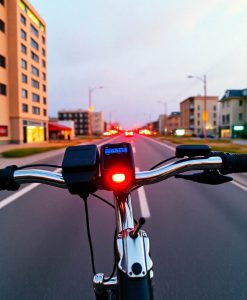When you’re out on your bike, feeling the wind against your face and the rhythm of your pedaling, it’s easy to focus on the road ahead—yet beneath that smooth ride lies a complex web of safety challenges. Ever notice how some parts of your usual route seem more nerve-wracking, where cars seem to drift a little too close or pass with less caution? That subtle tension, the feeling of proximity that makes your heart skip a beat, often goes unnoticed or unmeasured. Now, imagine if a tiny device on your handlebar could reveal those hidden danger spots—unmasking the areas that, over time, might pose real risks for cyclists.
This is exactly what the new system, called ProxiCycle, aims to do. It’s a small, affordable sensor that attaches to your bicycle handlebar, quietly tracking every time a passing vehicle comes within four feet—those moments when a car brushes too close and makes you flinch. The beauty of ProxiCycle isn’t just in its simplicity; it’s in its capacity to turn your everyday experiences into valuable data. Over weeks and months, this sensor logs close passes and sends that information straight to your phone, creating a detailed map of where danger tends to cluster along your route.
For cyclists, especially those navigating busy urban landscapes, understanding where these risky interactions happen can be transformative. It’s one thing to feel uneasy about a stretch of road or an intersection, but it’s another to see actual data showing where cars frequently come too close. That knowledge can empower you to choose safer routes, advocate for better infrastructure, or simply ride with more awareness. When you start to notice that certain turns or stretches consistently register close passes, it becomes clear where improvements are needed—whether through better signage, bike lane adjustments, or increased driver awareness.

The two-month trial in Seattle with 15 cyclists demonstrated the potential of this approach. The data collected revealed a meaningful link between the locations of close passes and other safety indicators, like collision hotspots. This isn’t just about collecting numbers; it’s about creating a clearer picture of the real risks cyclists face every day—risks that often remain invisible until a near-miss or a crash occurs.
Many urban cyclists have experienced that uncomfortable feeling of a car passing just inches away, a fleeting moment of vulnerability that can linger in memory. ProxiCycle’s sensor doesn’t just record these moments; it helps map out where they happen most frequently. Think of it as giving voice to the silent hazards that lurk along your usual cycling routes—hazards that, once visible, can be addressed and mitigated.
For those passionate about making biking safer, this technology offers a new way to understand and improve our shared roads. It reminds us that safety isn’t only about individual vigilance but also about collective awareness and infrastructure change. When cyclists have tools to identify danger zones, communities can rally around solutions—adding bike lanes, adjusting traffic flow, or implementing targeted safety campaigns.
If you ride regularly and want to understand the real safety dynamics of your routes, ProxiCycle’s small sensor could be a game-changer. It’s a step toward smarter, safer biking where data meets everyday life, turning personal experiences into powerful community insights. The next time you pedal through your neighborhood, know that those fleeting close passes could be part of a larger map—one that helps shape safer streets for everyone.
Learn More: A small bicycle handlebar sensor can help map a region’s riskiest bike routes
Abstract: Researchers have developed a system, called ProxiCycle, that logs when a passing car comes too close to a cyclist (four feet or less). A small, inexpensive sensor plugs into bicycle handlebars and tracks the passes, sending them to the rider’s phone. The team tested the system for two months with 15 cyclists in Seattle and found a significant correlation between the locations of close passes and other indicators of poor safety, such as collisions.
Link: Read Full Article (External Site)


